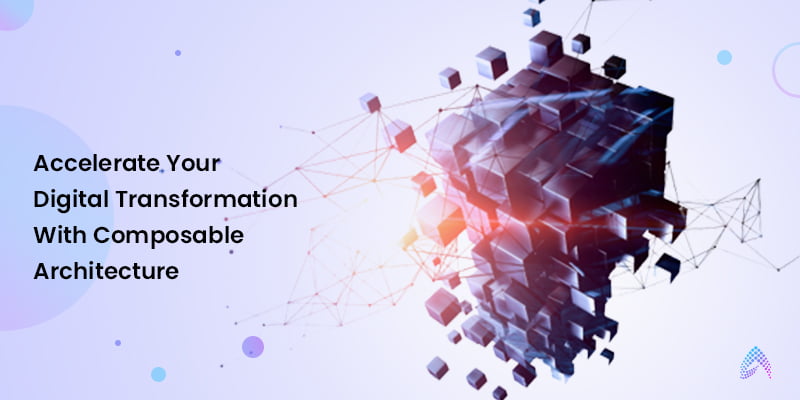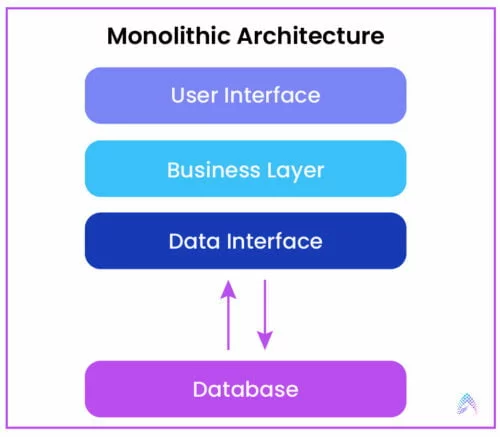Accelerate Your Digital Transformation With Composable Architecture

Did you know that one missing semicolon caused the Netflix website to go down for several hours? This happened in 2008-09 with Netflix when the platform had a monolithic architecture, one single codebase with interdependent functionalities. The missing semicolon was the cause of massive database corruption that eventually led to downtime.
By 2012, as demand grew rapidly for their video streaming services, Netflix migrated its IT infrastructure from a private data center to AWS – providing extensive computing resources and data centers with security and reliability at scale and replacing its monolithic architecture with small independent composable components called microservices.
Today, Netflix has around a thousand microservices that manage and support separate parts of the platform, allowing its engineers to deploy code frequently, sometimes hundred times every day.
Challenges with Monolithic Architecture:
1. Lack of agility:
Modern businesses need to be agile to keep up with constantly evolving market environments, and to do this they need access to agile applications that allow for constant upgrades and the addition of new features and capabilities. Monolith applications can often be too complex to allow for continuous development, integration, and delivery of features quickly or without downtime, and at low costs.
2. Availability of services:
Here is a typical example of the monolithic architecture of a web application. It consists of a big container, wherein all the software components and functionalities are assembled and tightly coupled. This monolithic application has a massive codebase that stores all the information that the application needs in order to function.

If your team wants to add any new feature or upgrade, they have to rework the entire code and rehost the entire application. As a result, development is typically quite slow. Furthermore, a bug in any module can bring down the whole application.
In monolithic architecture, if a server fails entire application crashes and stops responding, leading to customer drop-off and a bad experience. Frequent downtimes can hurt your customer acquisition, nurturing, and retention plans.
3. Large codebase and its associated difficulties in testing:
Monolith applications have a large code base. Since all the modules with different business logic are grouped into a single program and executed as a single process, understanding the code and its maintenance will become complex.
In monolithic architecture, you cannot isolate other parts of the codebase. You must redeploy the entire application on each update, making testing complex, resource-intensive, and expensive. In doing so, your team will hardly get less time to innovate and improve efficiency.
Above all, testing and bug-fixing cost will become expensive for small and mid-size businesses with monolithic applications and architecture. Depending on the stage of bug identification, the bug fixing cost would vary between $500 to $5000.
4. Inability to accommodate new security features:
Adding new features in a monolithic application may require changes in the code, and one of the common problems with legacy applications is a shortage of skilled resources who are familiar with the application. In the absence of such skilled personnel, code updates may not be feasible, or even possible.

Composable architecture: Future of applications
If a monolithic legacy application stops you from growing, it’s time to embrace modern architecture that can decouple large, complex systems into small and more manageable components.
One such modern architecture called Composable Architecture allows organizations to build rich and better applications to deliver future-ready digital solutions with fewer efforts. By breaking down traditional organizational silos, Composable Enterprise Architecture enables flexibility and agility in the face of digital disruption through APIs to integrate various business processes to create robust digital solutions.
PBCs in composable enterprise architecture:
Composable Architecture consists of interchangeable building blocks called Packaged Business Capabilities (PBCs) to create, innovate, and adapt business operations, enabling them to respond to external and internal factors at scale.
Example:
In the case of e-Commerce applications, which by nature are already using composable architecture models, they contain numerous customer-facing PBCs, i.e. shopping carts, chatbots, product listing modules, inventory management modules, recommendation engines, etc. independently. Online retailers use these interchangeable building blocks to develop best-of-breed applications.
Composable application Architecture is a transition from code-based software development to service-and-composition-oriented architecture with multiple interchangeable applications.
According to Gartner, organizations with composable architecture will implement new features 80% faster than their competitors with a traditional development approach.
Benefits of composable enterprise architectures in application modernization:
The primary benefit of the composable architecture is its greater technical agility that empowers organizations to quickly adapt to changing business needs.
It will enable you to free up from on-premises hassles and manage them via cloud platforms. Therefore, if your customers demand new features and functionalities, you can rapidly develop and deploy them to enhance customer experience.
In such cases, incorporating Low-code/No-code platforms can save your development team’s time by at least 40%. Since they use advanced drag-and-drop features, you can quickly develop and modernize applications in just a few hours compared to the tedious traditional approaches.
Other benefits of a composable architecture include quick scaling innovation and digital creativity. By enabling your development team to connect different software components with APIs, composable architecture helps your business create new productivity-increasing operations at a relatively low cost.
Composable architecture reduces the operational complexity of traditional workloads and helps your business become dynamic and resilient in the face of changing internal and external demands.
1. Development and testing will become easy:
Composable architecture empowered by Low-code/No-code platforms eliminates the hassles of large code and allows no-coders to develop process-specific applications, saving numerous productivity hours for developers.
In addition to LCNC platforms, exploratory or predictive testing methods further help organizations test their applications right from the planning stage, enabling quick and high-precision testing and saving testing costs.
2. Automation and upgrades will happen regularly:
In contrast to monolithic applications, composable application architecture, and applications can be developed, deployed, and upgraded quickly multiple times a day to meet evolving needs and address process-specific requirements.
Composable architecture combined with LCNC platforms accelerates automation and upgrades by at least 40x faster. With LCNC platforms, you can develop UI in just 5 to 6 hours and refine its process in just a few minutes compared to traditional monolithic applications.
3. Accelerates integration and innovation:
The Composable Architecture is driven by APIs and PBCs. Therefore, you can pick and integrate various functions without coding hassles and compatibility issues.
As you can develop departmental-level and process-specific applications, the composable architecture enables innovation across your organization. By incorporating AI and ML technologies, you can get the right data and build a secured composable architecture that scales according to your business needs.
What’s your next step:
Achieving a long-term and sustainable digital transformation requires continuous modernization of underlying technology that allows teams to work on different solutions simultaneously while eliminating manual and mundane operations.
Composable business architecture driven by Low-code and No-code platforms helps your businesses achieve better automation, deployment, and upgrades at scale than any other process.
This can propel your digital transformation efforts by 20X speed — allowing front-end developers can focus on the UX and the tech team can work on upgrading and scaling different bits and parts of applications without involving specialists every time. With this, you can easily plug robust and scalable applications into the enterprise ecosystem with little disruption.

President & CEO – Growth Markets




